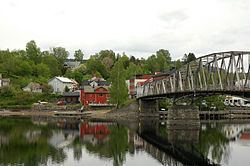Area 457 km² Local time Wednesday 1:04 AM | Demonym(s) Eidsvolling Population 18,338 (2004) | |
 | ||
Weather -4°C, Wind N at 8 km/h, 70% Humidity Points of interest Eidsvoll 1814, Eidsvollsbygningen, Stallgården | ||
Eidsvoll is a municipality in Akershus county, Norway. It is part of the Romerike traditional region. The administrative centre of the municipality is the village of Sundet.
Contents
- Map of Eidsvoll Norway
- Name
- Eidsvoll Church
- Coat of arms
- History
- Geography
- Notable residents
- Sister cities
- References
Map of Eidsvoll, Norway
Name
The first element is the genitive case of the word eid (Old Norse: eið) and the last element is voll (Old Norse: vǫllr) which means "meadow" or "field". The meaning of the word eid in this case is "a road passing around a waterfall". People from the districts around the lake (Mjøsa) who were sailing down the river Vorma, and people from Romerike sailing up the same river, both had to enter this area by passing the Sundfossen waterfall. Because of this, the site became an important meeting place long before the introduction of Christianity. Prior to 1918, the name was spelled "Eidsvold". The town of Eidsvold in Queensland, Australia and Eidsvold Township, Lyon County, Minnesota, United States still use this old spelling.
Eidsvoll Church
Eidsvoll church (Eidsvoll Kirke) is a cruciform church from approx 1200. It is part of the Norwegian Church and belongs to Øvre Romerike deanery in the Diocese of Borg. The Romanesque building is in stone. Eidsvoll church is repeatedly burned and rebuilt. The old church records were lost in a fire. The altarpiece in Eidsvoll church is from 1765. It is a wooden structure with three floors, decreasing towards the top, where each floor concludes with gilded pilasters with capitals and rococo decor on each side of a painting. The altarpiece was restored after a fire in 1883, the next restoration occurred in 1915 and a third restoration occurred late 1960s. Access to the church is a well traveled tourist destination is via Rv181 and Fv502 / Rv177. Pilegrimsleden goes through Eidsvoll. Eidsvoll church is one of the more prominent stops along the path, which was officially opened on 16 June 2002.
Coat-of-arms
The coat-of-arms is from modern times. They were granted on 20 November 1987. The arms show a balance as a symbol of justice. In the early Middle Ages a local court was established in Eidsvoll.
History
The parish of Eidsvold was established as a municipality on 1 January 1838 (see formannskapsdistrikt). The municipality of Feiring was merged with Eidsvoll on 1 January 1964.
Eidsvoll is mentioned in Old Norse manuscripts. In the 11th century, it became the site of court and assembly (ting) for eastern parts of Norway, replacing Vang, now a part of Hamar in Hedmark. Because of its access to the river Vorma and the lake Mjøsa has long provided a thoroughfare to northern parts of inland Norway. Historically the main industry of Eidsvoll was agriculture, though the soil is rich in clay. Eastern parts of Eidsvoll were for a short time the site of a minor gold rush when gold was found in 1758, and these areas are still known as Gullverket.
Eidsvoll Verk was opened to smelt iron ore by King Christian IV of Denmark in 1624, relying on the excellent water power from the Andelva river. In 1688, it was owned by the director of the Kongsberg Silver Mines, Schlanbusch, and remained in his family until 1781. Carsten Anker came into possession of works in 1794, at which time it was in decay since many of the surrounding forests required for charcoal had been depleted. He restored it and set up the production of stoves and similar iron goods. He also took residence in Eidsvoll in 1811, rebuilding the manor house which is now the Eidsvollsbygningen, the site where the constitutional assembly met to draft and sign the Constitution of Norway on 17 May 1814. Eidsvollsbygningen is today a famous museum.
In 1854, Eidsvoll became the end point for the first railroad line in Norway from Oslo. This became the transit point for travel with the steamship Skibladner to Hamar, Gjøvik, and Lillehammer. In addition to the historic Eidsvoll Church, Eidsvoll is the site of the Langset Church (Langset kirke) which dates to 1859 and the Feiring Church (Feiring Kirke) which dates to 1875.
Geography
Eidsvoll municipality is bordered on the north by Østre Toten (in Oppland county on the west side of Mjøsa) and by Stange (on the east side of the lake) and to the east by Nord-Odal (both in Hedmark county). In the county of Akershus to the southeast lies Nes, to the south lies Ullensaker, and to the west lies Nannestad and Hurdal.
In addition to being a commuter town for Oslo, it also has agriculture and forestry industries. The main population and commercial centres are Sundet and Råholt.
Notable residents
Sister cities
The following cities are twinned with Eidsvoll:
